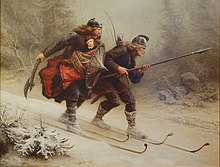Birkebeiner

Birkebeiner ( norrøn : birkibeinar) was the name of rebels and a political party during the Norwegian Civil War . Their first leader was Øystein Møyla (1157–1177).
The name comes from the propaganda of the political opponents, because the rebels had to flee into the woods after an initial defeat and in the cold they wrapped their calves with birch bark .
background
A rebellion crystallized on Øystein Møyla , the son of King Øystein Haraldsson and grandson of Harald Gille . Telemark joined the uprising against the rulers in the Oslofjord . They came plundering from the northern highlands. But the loins and peasants forced them back into the woods and into the wasteland. Øystein Møyla died in 1178 in the lost battle of Re.
The remains of the Birkebeiner gathered around Sverre Sigurdsson , who came to Norway in 1176 and had joined Øystein Møyla . They managed - with the support of the Swedish royal family - to get ships and they went to Nidaros , where they immediately found allies. There they attacked the supreme Lendmann (Lehnsmann) Erling Skakke of the city of Trondheim in 1177 , who had meanwhile been crowned King of Norway. Erling Skakke was killed in the battle. They feigned defeat and then attacked their opponents, who were drunk in victory frenzy. Sverre is said to have helped a fog in Nidaros , which was regarded as a divine sign. The saga ( Sverris saga ) tells of inhuman hardships and victories over the often superior opponent. The civil war was so cruel that it was immortalized in numerous sagas. When the dragon banner ( wyvern ) Sverris finally blew over Nidaros in 1177 , the Birkebeiner came to power.
Their success lay in their strategy, which was mainly developed by the leader Sverre Sigurdsson and which came close to today's guerrilla tactics. Sverre's style of warfare differed significantly from the traditional order of battle of concentrated fighters with the king's mark at the head and ships tied together in sea combat. He stayed more directing in the background and set up his troops in smaller, separate and very mobile units. Critics often interpreted this as cowardice.
He had larger and higher-sided ships built and built larger fortifications than was customary in Norway up to that point, in particular he preferred stone castles. In addition, he did not shy away from fighting at night (1183 against Bergen).
In 1178 or 1179 he defeated King Magnus Erlingsson , son of Erling Skakkes, in the battle of Kalvskinn and in 1180 in the battle of Ilevoll . In 1194 he was crowned by bishops who were kind to him . But it was not until the election of Håkon Håkonsson (Sverre's grandson) in 1217 that complete control was achieved. Sverre founded the noble family "Sverre-ætt". The Birkebeiner remained in power until 1319 Magnus Eriksson , when Magnus VII inherited the Norwegian crown and was elected King of Sweden as Magnus II a year later.
One story has made the Birkebeiner famous to this day: The Birkebeiner had already risen to become the ruling aristocracy when a new uprising was against them. The Bagler Wars began .
King Håkon Sverreson , the son of King Sverre, had just died, his son Håkon Håkonsson was still a toddler, as sought Bagler the child for life; for he was now the crystallization figure of the Birkebeiner with royal salvation. The saga reports that the Birkebeiner immediately brought him to King Inge II. Bardsson . After a break in Lillehammer (first mention of Lillehammer) at Christmas, the two best skiers Torstein Skjevla and Skjervald Skrukka did not take the normal route through Gudbrandsdalen , because of the baglers to be expected everywhere , but over the mountains to Østerdalen , and this in frost, snowdrifts and very bad weather. In memory of this special act, there are still the national races Birkebeinerløpet (long-distance running around 20 km), Birkebeinerrennet (long-distance cross-country skiing, around 50 km) and Birkebeinerrittet (long-distance cross-country cycling race around 90 km).
See also
literature
- Knut Gjerset : History of the Norwegian People . The MacMillan Company, New York 1915, OCLC 1674570 (on- line ).
- Knut Helle: Under kirke og kongemakt: 1130–1350 . In: Aschehougs Norges history . No. 03 . Aschehoug, Oslo 1995, ISBN 82-03-22031-2 .
- Karen Larson : A History of Norway . Princeton University Press, Princeton 1948, OCLC 614053106 .
- Andreas Holmsen : (Norges historie) fra de eldste tider til 1660 . Universitetsforlaget, Oslo 1939.
- Kåre Lunden : Norge under Sverreætten, 1177–1319 . In: Cappelens Norges history . No. 3 . JW Cappelen, Oslo 1976, ISBN 82-02-03453-1 .
- Claus Krag : Sverre: Norges største middelalderkonge . Aschehoug, Oslo 2005, ISBN 82-03-23201-9 .
Web links
- Birkebeiner in the norske leksikon store